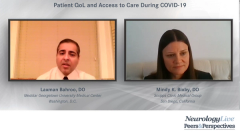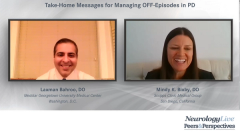
Take-Home Messages for Managing OFF Episodes in PD
Mindy K. Bixby, DO and Laxman Bahroo, DO give key advice to community neurologists and emphasize the importance of effective communication between patients and providers.
Episodes in this series

Laxman Bahroo, DO: What take-home messages do we have for the community neurologists? My main take-home point for community neurologists is query the patients. If they’re having motor OFF episodes, if they’re having OFFs, they’re not able to function. Ask about that, even if they’re not reporting it, ask about those things, because the OFF episodes according to studies are ubiquitous, folks have them, and they have them for a long time. Individuals may not have the vocabulary to communicate about OFFs, but if they’re missing things, missing appointments, missing activities, much of that may be due to these OFFs that they’re experiencing. What is your take-home message?
Mindy K. Bixby, DO: I agree, absolutely. I think that if anything, I want them to know that there are so many options, and we talked about that, there are so many things we can do to help them. There are ways to bridge the gap, is basically what I want them to know. Also, if you’re able to ask them, sometimes even down to a Parkinson diary where they follow themselves every 30 minutes for a day so you can look at a piece of paper and say, “Wow, you’re going. what’s happening here? Why are you having more stiffness and slowness around these times?” Then you can open the conversation about OFF and be able to let them know, “Hey, let’s figure out some way to actually get you to these times of feeling better so you don’t feel like you’re having that moment.” Sometimes that is the most important data you can have in that visit, because a lot of times they say, ”Everything’s fine,” but then you realize differently as you dive a little bit deeper, which I think is important for neurologists and caregivers and patients to know. There are ways to help if we actually understand what’s happening to the body and how it should be. If you ask the question, you will absolutely help them.
Laxman Bahroo, DO: Absolutely, and I think that’s the same advice both for patients and caregivers. If you’re experiencing OFFs and your medications aren’t working like they used to, or like you expect them to, bring it up to your health care professional. If it’s a priority, lead with that in a visit. The advice I give my patients is to you lead with the thing that bothers you. You have to make a list of the top 1, 2, or 3 things that can be covered, and if we can’t get to it, we’ll cover it in a second visit. However, it’s important in this era if smartphones, if you’re not sure what’s OFF and what’s ON, video tape it. Make a video of 30 seconds, and bring it to your neurologist, let them look at it and say, “I can see a difference, you’re much slower and stiffer here than you are in my office. What happened here?”
Mindy K. Bixby, DO: Absolutely.
Laxman Bahroo, DO: Journal it.
Mindy K. Bixby, DO: We also know with neurologists or whenever you go to the doctor, you’re on your best behavior.
Laxman Bahroo, DO: Absolutely.
Mindy K. Bixby, DO: Sometimes you’re motivated and you’re walking around, and the other person’s saying, ”He has never looked like this at home.” Asking everybody around them as well may be helpful with getting a little better of an understanding of a picture of a daily moment for this patient.
Laxman Bahroo, DO: That very much is the bane of the spouse of someone with Parkinson disease. “They never look like this; this is not how they walk.” I always tell them, “This is what happens when you’re under observation. They’re capable of this, but we really want to be able to do that.” We don’t see as many folks in the OFF. I would interject one important point. One advantage of a virtual visit is we get to see folks in their home environment.
Mindy K. Bixby, DO: Exactly.
Laxman Bahroo, DO: Because of that, we may get to see them at an OFF time because they would never do a visit at 8:30 or 9 o’clock, but they will do a virtual visit. Therefore, you get to see and they‘re like, “I took my medication an hour ago and look, it didn‘t take effect.“ We get to see them in their OFF state, whereas we may not do that in the office. I think there are advantages to virtual visits there.
Mindy K. Bixby, DO: I agree. I didn’t think about that, but you’re right. You can look around a little. I also feel like you’re coming into their home, like a home visit, which is pretty amazing, too. It gives you an opportunity to see their life in a different realm, and I think that is wonderful.
Laxman Bahroo, DO: Perfect. This was wonderful, time did float by, I agree.
Thank you for watching this NeurologyLive® Peers & Perspectives®. If you enjoyed the content, please subscribe to the e-newsletters to receive upcoming programs and other great content in your inbox.
Transcript Edited for Clarity
Newsletter
Keep your finger on the pulse of neurology—subscribe to NeurologyLive for expert interviews, new data, and breakthrough treatment updates.




































